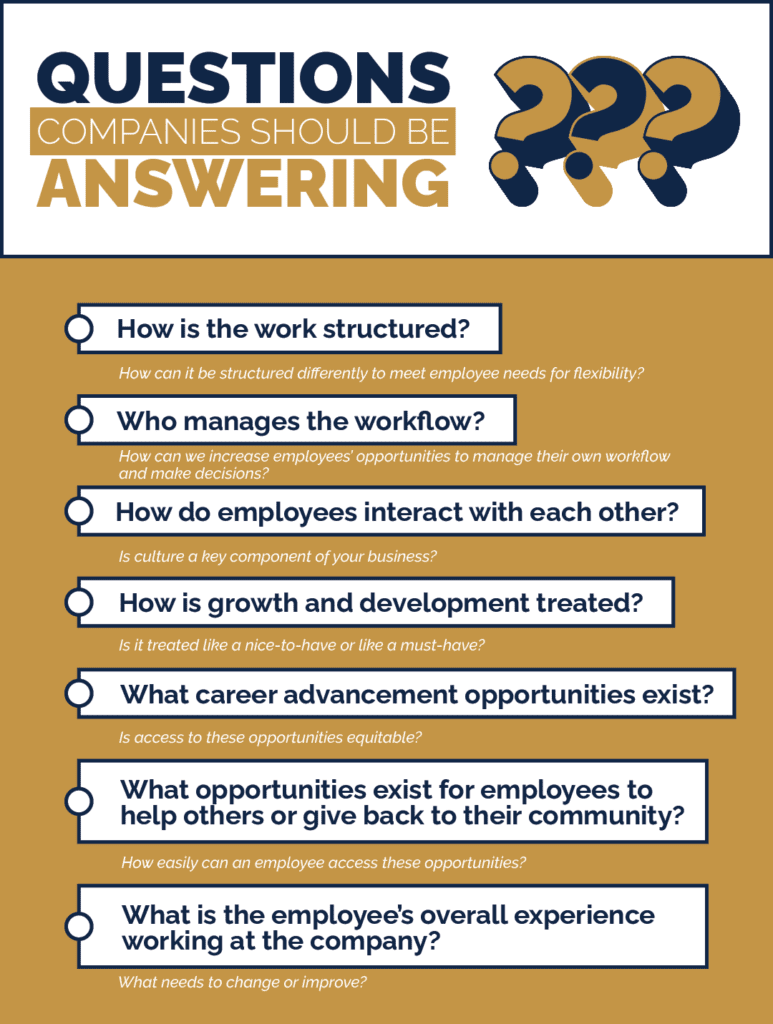Beyond the Benefits Package: Offering Employees A Better Quality of Life
At the turn of the 20th century, life expectancy was roughly 30 years and most people worked as craftsmen or as farmers. They only stopped working when they no longer were physically capable of doing the work.
No need for “retirement” funds or healthcare benefits. If you lived to old age your family took care of you. There wasn’t time off for vacations and if you became ill, chances were high that you would not recover. Life was hard.
It wasn’t until the industrial revolution that people began trading their independence for a better quality of life. Companies were in search of workers who they could pay just enough to not lose them to a competitor, but who would also stop working for them when they became too old or too costly.
Here lie the historic roots of the benefits package in the form of the pension plan. Many related tax and employment laws were followed to create the pre-pandemic expectations for a benefits package that we have all accepted as the norm.
How the Benefits Package Has Evolved
Workers’ expectations for what is included in a “standard” benefits package have changed and evolved over the past 40 years.
For example, the 1978 Revenue Act effectively marked the birth of the 401(k), which is today’s typical retirement benefit offered to employees. Few job seekers expect a pension, but most expect some sort of retirement plan, along with health care, paid time off, flex spending, health reimbursement or savings accounts, life insurance, and education assistance.

Creative or more progressive employers might offer gym memberships, ping-pong tables, or unlimited sick or vacation time.
If an employer could offer a little something more than the next employer, it could attract and retain employees. Competitive wages and benefits, plus a sense of security, were enough to get people to trade in their independence.
But now the tables have turned. In the aftermath of the pandemic, people discovered that they want something different for their lives and are looking at the role work plays in creating the life they want.
To experience a high quality of life, one must experience a high-quality work life.
While all well-being does not flow from one’s work, work certainly exerts a significant amount of influence on an individual’s overall well-being or lack thereof.
Work brings with it its own social circles and company culture, environmental conditions, and impacts on physical, mental, and financial well-being.
Work can provide a person with a sense of purpose and community. Work life is a microcosm of life.
People are rejecting the notion that they must sacrifice other areas of their lives for work. There has been a steep rise in the number of start-ups and entrepreneurship globally, with a 96% increase in the US in 2020 vs 2019 according to an April 2021 Forbes article.
In addition, a June 2022 Bloomberg article noted that half of these new entrepreneurs are women, up from 28% in 2019, and reported the key contributing factor to this uptick was women seeking better opportunities and flexibility in their lives, especially as it relates to child care.
 People are willing to take risks and forgo the security a company brings and be their own boss if it affords them what they want and need to have a higher quality of life.
People are willing to take risks and forgo the security a company brings and be their own boss if it affords them what they want and need to have a higher quality of life.
How You Can Help Improve Employee Well-Being
So, what is a company to do?
Clearly, we are experiencing the next evolution of what employees expect as a “benefit” from the companies they work for, and companies are now competing not only with each other but with the option potential employees have to go solo.
To compete, companies need be considering and questioning innovative ways to approach all aspects of work and how they can make adjustments that improve the quality of life for the people who work for them.
Companies need to be asking employees about what they need to generate well-being in their lives and to stay motivated to work for the company. Companies should be analyzing how the company is or can meet these needs.
Examples of questions companies should be answering include:
- How is the work structured? How can it be structured differently to meet employee needs for flexibility?
- Who manages the workflow? How can we increase employees’ opportunities to manage their own workflow and make decisions?
- How do employees want to interact with each other?
- How is employee growth and development treated? Is it treated like a nice-to-have or like a must-have?
- What career advancement opportunities exist? Is access to these opportunities equitable?
- What opportunities exist for employees to help others or give back to their community?
- What is the employee’s overall experience working at the company? What needs to change or improve?

Solutions and offerings that support employees in generating a higher quality of life will most likely not be a one-size-fits-all solution.
While this information can certainly be looked at in the aggregate to inform larger company offerings, policy changes, or programs, generating an understanding of what employees want and need, what motivates them, and how best to reward them would need to be done on an individual level.
Using a scientific approach and partnering with experts in employee motivation, human behavior, and organizational development is recommended.
Often companies survey employees or create and perform stay interviews but fail to ask the right questions in the right way.

In addition, knowing what to do with the information and how to implement solutions that change behavior and improve psychological well-being often is not part of an in-house skill set. Implementing this type of analysis, if done poorly, can actually do more harm than good.
PSP Metrics has been at the forefront of science-backed employee assessments and measurement systems for over 75 years. Our mission has always been to help give you a competitive business advantage through your company’s most valuable resource — your people.

Dr. Nicole Scott
Dr. Nicole C. Scott is a Principal Psychologist at PSP Metrics. Her expertise is in talent gap analysis and development, individual performance development, team development, employee engagement, DEI, and coaching (individual, team, and group), with a deep expertise in job evaluation, competency modeling, succession planning, and both high potential mid-level leader development and frontline worker career development programs. Dr. Scott can be contacted at: nscott@pspmetrics.com or via LinkedIn.
Comments are closed.

